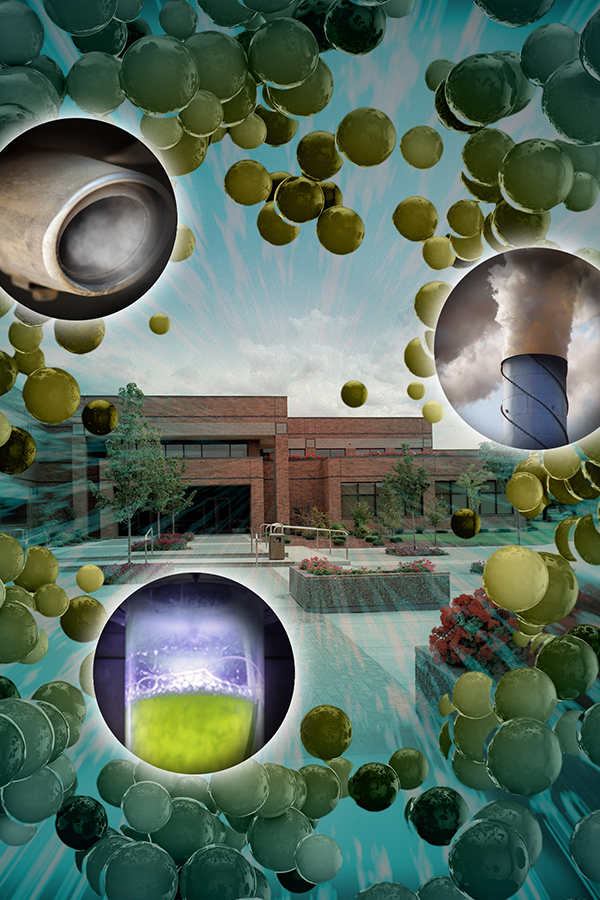Catalyze It! Special Issue Highlights Drive for Discoveries at National Labs
(May 2016)

Catalysts that make reactions occur faster and with less energy are a key part of reducing emissions from today’s power sources and building new ones for tomorrow. The Department of Energy’s national labs are at the forefront of such research. Selected studies from the labs appear in the special issue of ACS Catalysis. Artwork by Nathan Johnson, PNNL.
Congratulations to the researchers at Pacific Northwest National Laboratory and ten other laboratories who have their work featured in a special issue of ACS Catalysis. At the national laboratories, scientists conduct a broad range of catalysis work. Their research has clarified the principles underlying basic catalysis science, funded by DOE's Office of Science, and has resolved issues for biofuels, advanced emission control to enable efficient engines, fuel cells, and more, funded by DOE's Office of Energy Efficiency and Renewable Energy. The peer-reviewed online publication features ten articles by PNNL scientists and their university collaborators:
Virtual Special Issue on Catalysis at DOE's National Laboratories. R. Morris Bullock, Charles H.F. Peden, and Yong Wang joined with others to cover the history and impact of catalysis work at the national labs supported by DOE through funding, user facilities, and collaborations.
Review: Nanostructured Electrocatalysts for PEM [Proton Exchange Membrane] Fuel Cells and Redox Flow Batteries. Yuyan Shao, Yingwen Cheng, Wentao Duan, Wei Wang, Yuehe Lin, Yong Wang, and Jun Liu discuss recent progress at PNNL on designing catalytic materials for fuel cells and certain battery types vital for sustainable, low-carbon energy. They also describe the synergy between fuel cells and batteries.
A Molecular Copper Catalyst for Hydrogenation of Carbon Dioxide to Formate. Christopher M. Zall, John C. Linehan, and Aaron M. Appel show that a copper complex can catalyze the addition of hydrogen to carbon dioxide in the presence of a suitable base to create energy-rich formate. Further, the team shows how the base plays an unusual role in activating the hydrogen and producing formate.
Origin of Coverage Dependence in Photoreactivity of Carboxylate on TiO2(110): Hindering by Charged Coadsorbed Hydroxyls. Zhi-Tao Wang, Michael A. Henderson, and Igor Lyubinetsky show that adsorption of trimethyl acetic acid on the surface of a model titanium dioxide catalyst causes the buildup of negatively charged bridging hydroxyls. These species inhibit the light-induced catalytic reaction that is mediated by positively charged photo excited carriers.
Ab Initio-Based Kinetic Modeling for the Design of Molecular Catalysts: The Case of H2 Production Electrocatalysts. Ming-Hsun Ho, Roger Rousseau, John A.S. Roberts, Eric S. Wiedner, Michel Dupuis, Daniel L. DuBois, R. Morris Bullock, and Simone Raugei modeled every elementary step in the complicated mechanism of producing hydrogen, offering a detailed map of energy flow for the different routes the reaction could take.
Manganese-Based Molecular Electrocatalysts for Oxidation of Hydrogen. Elliott B. Hulley, Neeraj Kumar, Simone Raugei, and R. Morris Bullock demonstrated that splitting hydrogen molecules into electrons and protons, a key reaction for functioning fuel cells, can be done with catalysts made from earth-abundant manganese complexes that contain dangling nitrogen atoms in specialized molecular scaffold around the metal center.
Effects of Alkali and Alkaline Earth Cocations on the Activity and Hydrothermal Stability of Cu/SSZ-13 NH3-SCR Catalysts. Feng Gao, Yilin Wang, Nancy M. Washton, Márton Kollár, János Szanyi, and Charles H.F. Peden discuss a three-step method for modifying a copper-based catalyst to reduce undesirable reactions and enable the catalyst work at lower temperatures-vital for reducing nitrogen emissions from a new generation of combustion engines.
Mechanism of CO2 Hydrogenation on Pd/Al2O3 Catalysts: Kinetics and Transient DRIFTS-MS Studies. Xiang Wang, Hui Shi, Ja Hun Kwak, and János Szanyi show that on large palladium particles, the abundance of active hydrogen atoms promotes the formation of energy-rich methane fuel from carbon dioxide, but on smaller particles, less hydrogen is available, and the reaction produces mostly carbon monoxide.
Elucidation of the Roles of Re in Aqueous-Phase Reforming of Glycerol over Pt-Re/C Catalysts. Zhehao Wei, Ayman Karim, Yan Li, and Yong Wang provide insight on how addition of rhenium to a platinum/carbon catalyst significantly improves its activity in reforming glycerol. The results shed light into how to improve a catalyst for turning biomass into fuel.
Steam Reforming of Ethylene Glycol over MgAl2O4 Supported Rh, Ni, and Co Catalysts. Donghai Mei, Vanessa Lebarbier Dagle, Rong Xing, Karl O. Albrecht, and Robert A. Dagle compare the hydrogen yield achieved by metal catalysts used for steam-reforming ethylene glycol to produce hydrogen fuel. The findings show a cobalt catalyst has a much higher hydrogen yield than rhodium or nickel catalysts.
Acknowledgments
Much of the catalysis research discussed here was funded by the Department of Energy, including an Energy Frontier Research Center funded by the Department of Energy, Office of Science, Office of Basic Energy Sciences. The Office of Science is the single largest supporter of basic energy research in the physical sciences in the United States and is addressing some of the most pressing challenges of our time. The Office of Energy Efficiency and Renewable Energy funded much of the applied research.
